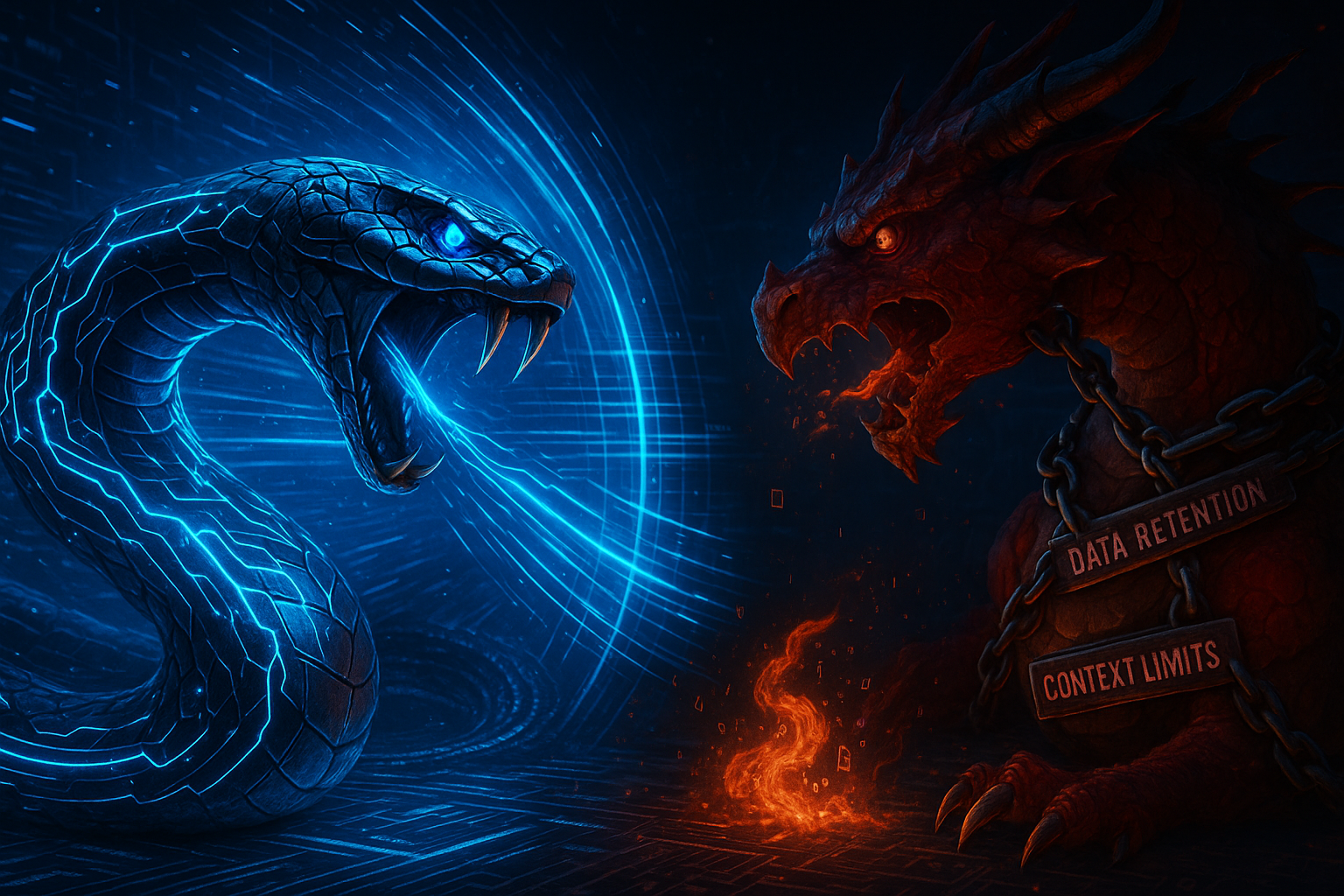Snake Query vs RAG: The Battle for AI-Powered Data Processing Supremacy
9/21/2025

The AI world is witnessing an intense competition between two fundamentally different approaches to data processing: RAG (Retrieval Augmented Generation) and Snake Query. But what are the core differences between these technologies? Which one truly offers superior advantages? In this deep-dive analysis, we'll explore these two systems and uncover which approach is reshaping the future of data processing.
What is RAG? A Quick Overview
RAG converts your data into vector format and stores it in a specialized database, then enables AI models to retrieve information from these vectors to answer queries. Simply put: it transforms your data into numerical formats that AI can understand and uses this "learned" information to respond to your questions.
What is Snake Query? A Revolutionary Approach
Snake Query operates on a completely different philosophy. Instead of sending your data to AI models, it uses the innovative VEX Algorithm - a sophisticated system that performs intelligent operations directly onyour data. Here, AI is only used to understand your query and create processing plans, never actually "seeing" your data.
4 Critical Comparison Points
1. 🛡️ Data Security: The Privacy Revolution
RAG's Reality:
AI models see and learn from all your data
Your data is permanently stored in embedding format
Vector databases can be hacked
High risk of data leaks
Snake Query's Guarantee:
AI knows absolutely nothing about your data
Data is never stored anywhere
Complete data destruction after processing
Zero-knowledge principle ensures 100% security
2. ⚡ Data Processing Capacity: Breaking the Limits
RAG's Limitations:
GPT-4: 128K token limit (~100 pages of text)
Claude: 200K token limit (~150 pages of text)
Only small portions of large datasets can be processed
Snake Query's Power:
No limits whatsoever
Millions of records processed seamlessly
Complete dataset analysis guaranteed
Real-world example: You have 1 million customer records. While RAG can only process 10,000 of them, Snake Query analyzes every single one.
3. 🔢 Mathematical Precision: Guesswork vs Certainty
RAG's Challenge:
AI models "estimate" mathematical operations
Similarity search produces approximate results
Accuracy rate around 60-75%
Hallucination risks present
Snake Query's Strength:
Direct mathematical operations on data
95-100% accuracy guarantee
Zero hallucination
Mathematically precise results
Example: When you ask "Calculate the average sales growth for the last 6 months," RAG estimates while Snake Query computes exactly.
4. 💰 Cost Impact: Budget Revolution
RAG's Expenses:
Vector DB hosting: $500-2000/month
Embedding API: $300-800/month
Infrastructure: $1000-3000/month
Total: ~$4500/month
Snake Query's Economics:
Average $0.145 per query
Data size irrelevant
Zero infrastructure costs
Total: ~$200/month
Cost difference: 95.6% savings!
Does RAG Have Any Advantages?
Certainly. RAG can be preferred when:
Working with small datasets
Building general conversation applications
Non-critical information requirements
Imperfect results are acceptable
Which Industries Benefit Most from Snake Query?
Fintech: Sensitive financial calculations
E-commerce: Large product catalog analytics
Healthcare: Patient data analysis (HIPAA compliant)
Human Resources: Employee performance analytics
Manufacturing: Production data analysis
Real-World Performance Comparison
Let's examine a concrete scenario: analyzing 500,000 e-commerce transaction records.
RAG Performance:
Processed records: 8,000 (1.6% of total data)
Processing time: 75-155 minutes
Accuracy: ~65% (due to incomplete data + similarity errors)
Cost: $850+ per analysis
Snake Query Performance:
Processed records: 500,000 (100% of data)
Processing time: 11-17 seconds
Accuracy: ~97% (complete data + direct processing)
Cost: $12 total
The Security Revolution
In an era where data breaches cost companies millions and GDPR fines reach unprecedented levels, Snake Query's zero-knowledge approach isn't just technically superior—it's legally essential.
RAG's Security Nightmare:
Your sensitive data becomes part of AI training
Embedding vectors can be reverse-engineered
Third-party AI services create exposure points
"Deleted" data often remains in embeddings
Snake Query's Security Promise:
Military-grade data privacy
Zero data retention policy
Perfect GDPR/HIPAA compliance
Complete data sovereignty
The Future is Clear
The comparison reveals a technology that's not just incrementally better, but fundamentally revolutionary. Snake Query's VEX Algorithm represents a paradigm shift from "teaching AI about your data" to "using AI to process your data intelligently."
For businesses prioritizing:
✅ Data security → Snake Query
✅ Large-scale data processing → Snake Query
✅ Mathematical precision → Snake Query
✅ Cost efficiency → Snake Query
The verdict is overwhelming. While RAG was certainly an important technological development, Snake Query's zero-knowledge approach and unlimited data processing capacity position it as the clear winner for enterprise-grade applications.
As we move into 2025 with increasing data privacy regulations and security concerns, Snake Query isn't just offering better technology—it's offering the only truly secure way to harness AI for data processing.
The question isn't whether Snake Query will dominate the market, but how quickly organizations will adopt this revolutionary approach to stay competitive and compliant.
What's your take on this technological shift? Are you ready for the zero-knowledge revolution in AI data processing?
